
Individualized Path
The power of personalized learning comes from leveraging individual learner interests to teach the course content. This allows educators to think more broadly on what exactly they want to be learned, and then provide authentic and meaningful learning experience for each learner.
The following examples are real capstone projects that learners in my class worked on that combine their career aspirations with the music technology curriculum, in addition to how I work to nurture their own individual paths.
Co-Planning and Designing
As learners progress through my music technology courses, they come to realize the wide variety of careers related to the class. From a top 40 musician to a recording engineer or a foley artist to a lawyer, the jobs are pretty endless. By the time the they reach the third course, they have a pretty good idea of which aspect of the curriculum they enjoy the most. To help nurture their interest, I work with them to plan and develop a capstone project which focuses our curriculum around their chosen path.
Music Law
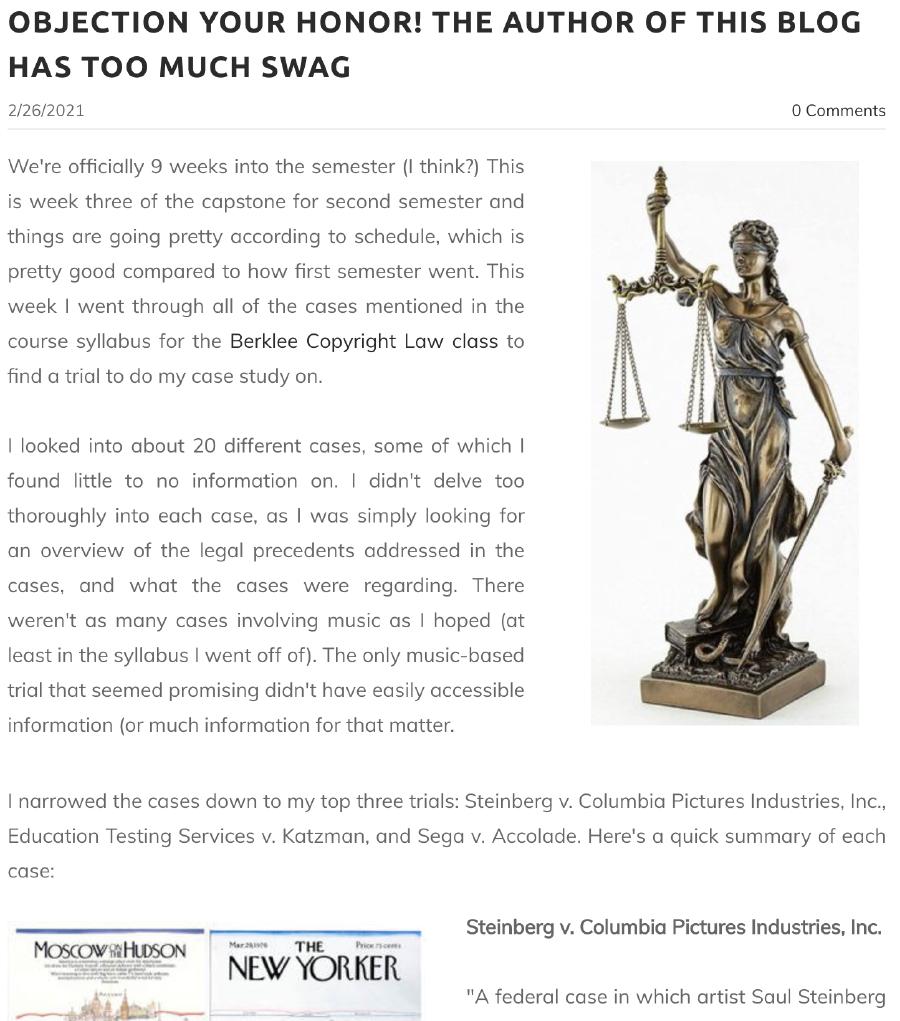
Kendall is a senior and third-year music technology student. She loves playing and composing music, but she has always been interested in a more business-oriented role in the music industry. As a member of the school’s mock trial team, she was very interested to look at copyright law and how it relates to music. In our co-planning sessions, we developed a project which asked her to look at six different high-profile copyright law cases and then select one to learn more about.
For her project, she would read and learn about copyright law, learn what the prosecution and defense arguments were, learn what the judge’s position was, and then make her own judgement on the case using her knowledge of the law and music. As part of this process, she would look at all referenced law and finally create a presentation for the class. This project ended up covering a variety of content standards from Music Technology, English, and Public Speaking while also addressing her interest in music and law.
Arranging for Brass Quintet

Hector is a junior and third-year music technology student. He is an All-State french horn player and hopes to one day be a professional orchestral musician. With this in mind, he has been interested in writing and arranging music that he and his friends could play. In our co-planning sessions, we developed a project which asked him to find a piece of music that he could arrange for brass quintet.
For his project, he would learn more about music theory and chord voicings, select a piece of music, transcribe all the musical elements, and arrange the song for brass quintet. This would culminate in a performance and recording of his arrangement as well as publishing the work for sale on Sheet Music Plus’s ArrangeMe platform. This project ended up covering a variety of content standards from Music Technology, Music Theory, and Band while also addressing his interest in music and recording.
Artifacts of Data
When learners select their topic, they always hit the ground running. Everything goes well for about two weeks and then they begin to lose steam. The following are examples of how I utilize the data they and their projects provide me with to assist them with how to direct their learning so that they continually make progress.
Redirecting Focus
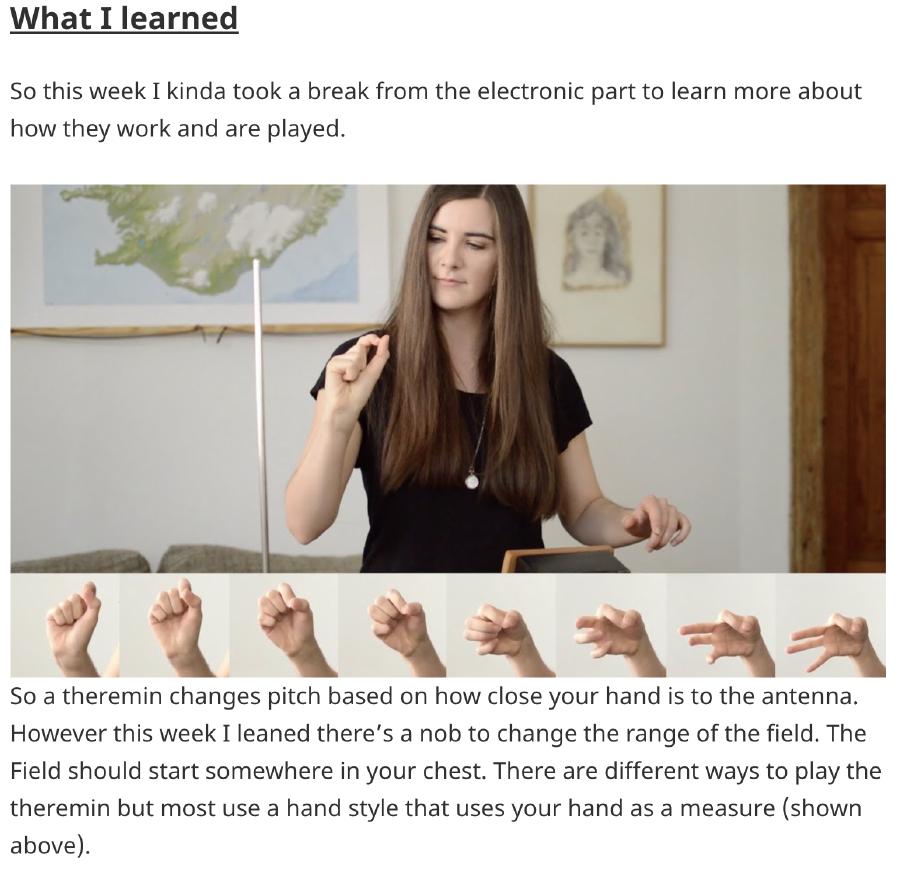
Nathan, a junior and third-year music technology student, decided that he wanted to build a theremin for his capstone. At the start of the project, he began looking at electrical diagrams to determine what he needed to build it. When we had our co-planning session, I began asking him about the diagrams and how a theremin works. I quickly realized that he a) had never read electrical diagrams before and b) didn’t really understand how the theremin worked.
His initial lift was more than he could handle at that point, which led to him not making progress and getting frustrated. As we talked, we decided to have him leverage his musical experience to learn how the theremin is played. This would then allow him to better understand all the electrical components and how they interact.
Connecting with an Expert
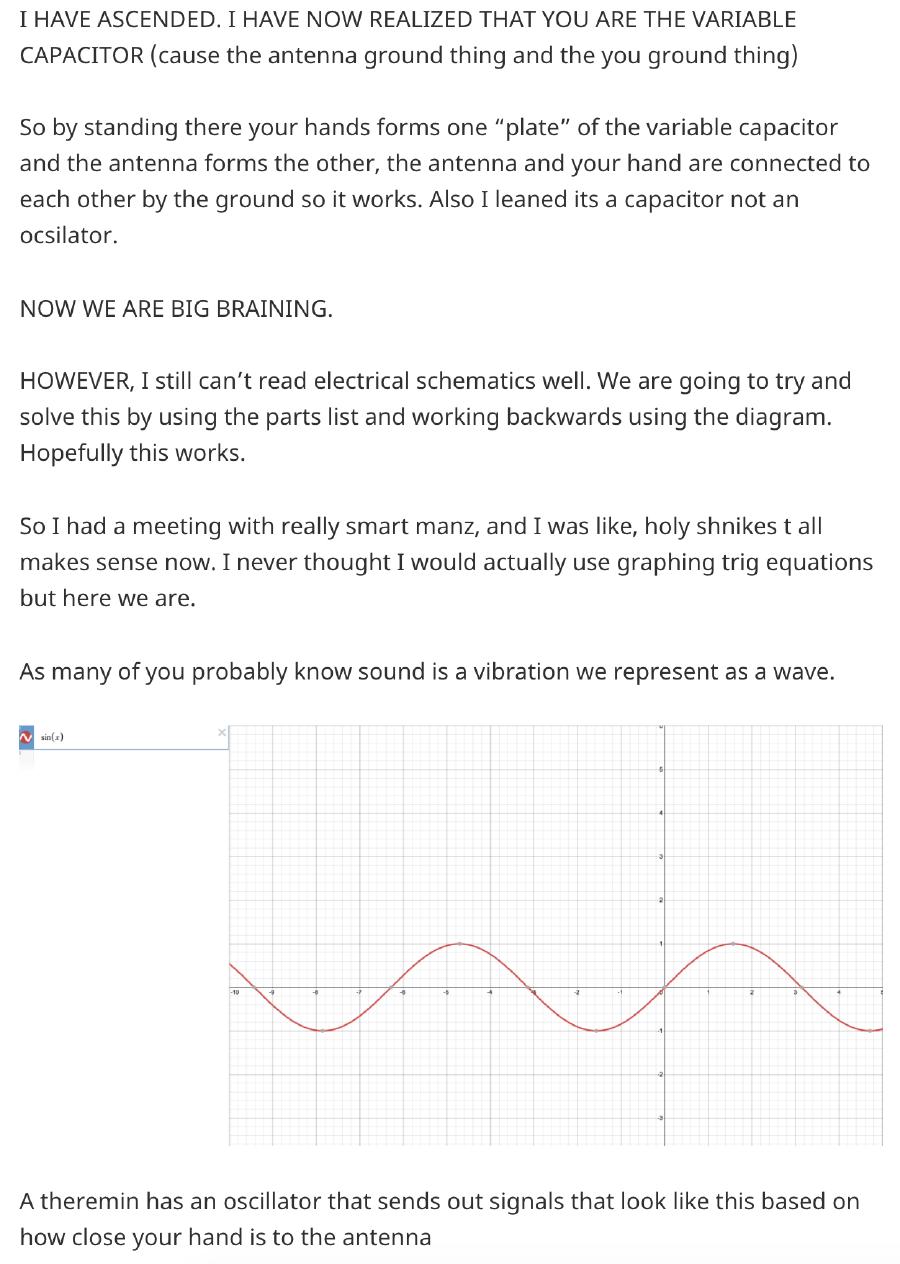
During the next co-planning session, Nathan had learned more about the theremin including a better understanding of what the different poles and knobs on the instrument do. This knowledge allowed him to better understand the electrical diagram when he revisited it; however, he still struggled with which part of the diagram was generating the sound and how that sound was generated. After looking at a couple of resources on his own and still not understanding, he reached out to me for help.
Unfortunately, this was outside my knowledge set but I had a friend in mind that could better explain everything to him. We were able to set up a Google Meet for them to talk for about two hours. During this time, my friend took advantage of Nathan’s prior knowledge of math and trigonometry to explain everything. This resulted in him having an even better understanding of the diagram and how the theremin produces sound. Additionally, my friend provided him with an easier alternative to making a theremin. After discussing it, Nathan felt like the conversation was productive enough that he felt comfortable continuing to pursue the more difficult approach.
Changing the Approach
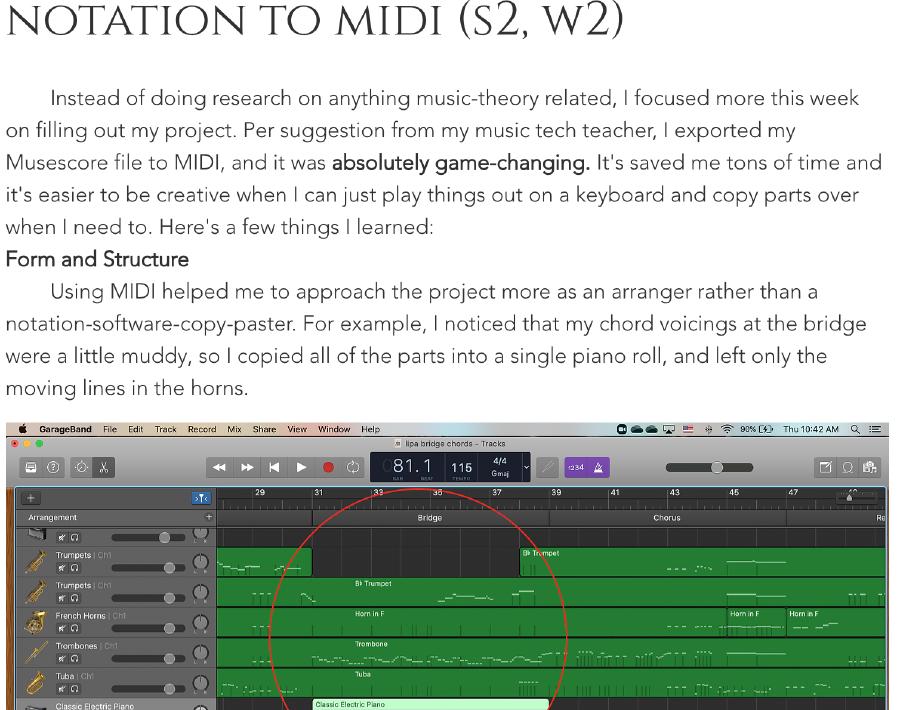
When Hector started working on his arrangement, he decided to start by working in notation - something he was super comfortable from having played french horn for six years. During our co-planning session, he told me that everything was going great but he was starting to run into trouble as he transitioned from transcribing to arranging - particularly when adjusting the orchestration.
As a horn player, he is used to reading only a single instrument’s music at a time. When working with notation software, he has to read an entire score of music (in this case, five instruments) which is a skill that has to be developed over time. Since his deficiency in this skill was preventing him from making progress, I suggested that he finish orchestrating his arrangement in a DAW, which would allow him to view all the music in a single line. Not only would this remove a barrier from his progress, but it also redirected his path from what he taught would work well for him to something that a significant improvement.
Artifacts of Coaching
One of the hardest aspects of a capstone project like this is that many learners have never had this much freedom in an assignment before. They have moments where everything is going great, and they have moments of genuine struggle as they learn more about how they consume knowledge. The following are examples of how I help coach learners through their struggles while also keeping them in charge of their project.
Setting Goals
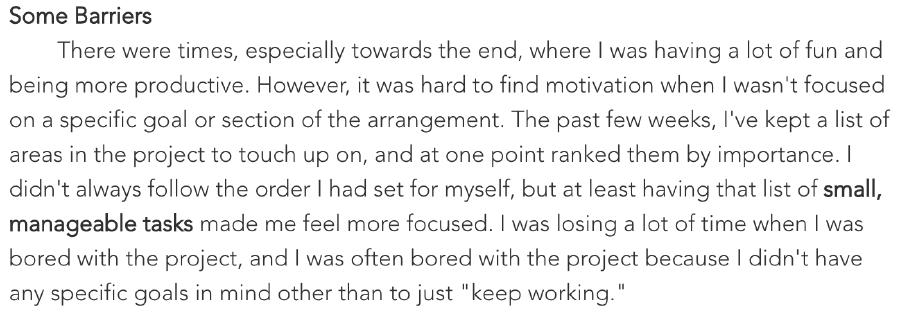
During our co-planning sessions, the learners and I work together to establish their learning and working goals. The purpose of having them set goals is to allow them to begin internalizing and visualizing the steps it takes them to get from where they are to where they want to be.
During the first session, the goal is their overall goal for the capstone - what they want to learn and what they want to create. As the semester progresses, I prompt them to create more incremental goals to guide their week-to-week progress - what happens next, where are we in the timeline, when and how is this going to be completed. At the start of the next session, we review their goal(s) for the week and discuss if they achieved it and what did or did not work. This provides an opportunity for me to coach them in goal creation - particularly incremental goals - as well as helping them reflect on their weekly process working on those goals.
Suggest Research
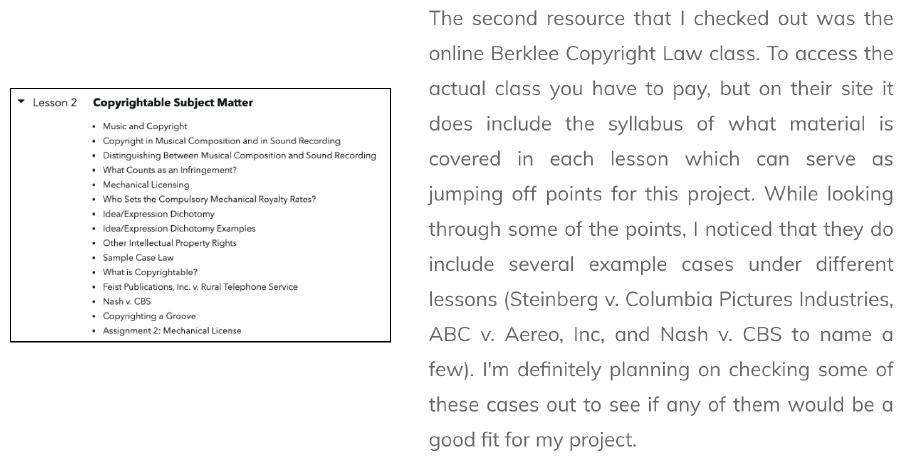
At the start of each co-planning session, the learners provide me with a summary of all they completed since our last meeting. This includes what research they have done, what articles they have read and videos they have watched, what their main takeaways were, and where they are on their project. During this process, I can ask questions about their work and understanding of their topic, and they are able to ask me for clarification for anything they are confused over. After we discuss what they have done, we begin to look at what is coming up by setting goals.
Once they have decided their goals for the week, I begin to ask them what the focus of their research is going to be - whether it’s a new aspect of their topic, or if it is digging deeper into what they had been researching already. This is when I take the opportunity to coach them on how they should conduct their research. For learners that are feeling confident about their project, I might simply suggest search terms to help narrow their focus. For learners that are a little shakier, these suggestions may be a specific topic to explore next or it might be very specific resources.
Reflections
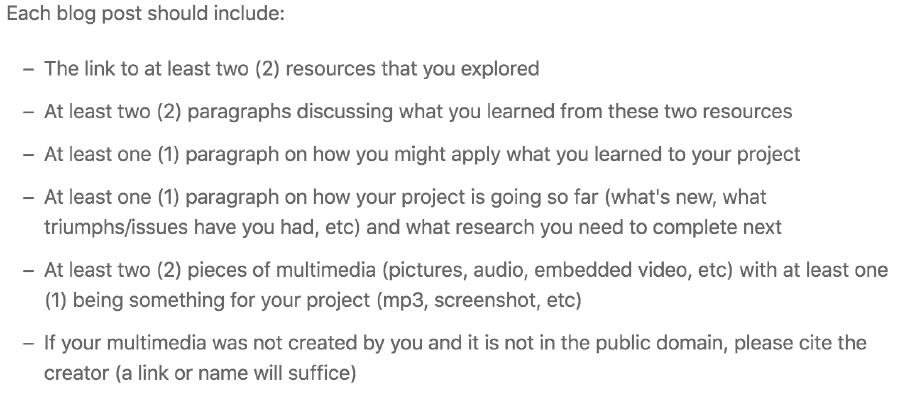
In addition to co-planning sessions, each learner maintains a personal blog as part of their capstone. This blog serves a variety of purposes, but the most important is as a tool for them to reflect on the process and increase their self-awareness. Prior to their capstone in my class, many learners have had limited experience with self-directed learning; they are used to being told exactly what to do and when to do it. By having them blog frequently, they begin to recognize patterns in how they approach research, learning and their projects.
During our mid-semester co-planning session, I ask the learners about the patterns they have noticed and then I highlight what I have noticed in their reflections. Not only does this result in them recognizing missed opportunities and encourage them to seize them going forward, but it always increases their self-awareness during the process of making changes from what doesn’t work for them to what does.
Resources
Education Review Office. (n.d.). Teaching approaches and strategies that work: 9. Developing student agency and motivation through effective teaching as inquiry. New Zealand Government. https://www.ero.govt.nz/publications/teaching-approaches-and-strategies-that-work/developing-student-agency-and-motivation-through-effective-teacher-practices-and-inquiry/
Gertz, M. (2018, October 1). You Can’t Win in a Classroom: The Benefit of the Individualized Path. Kennesaw State University. https://iteach.kennesaw.edu/blog/posts/you_cant_win.php
Personalized Learning Team (n.d.). Personalized Learning Pathways. The PL Toolbox. https://www.thepltoolbox.com/learningpathways.html
Smith, P. (2014, November 10). The Coming Era of Personalized Learning Paths. EDUCAUSE Review, 49(6). https://er.educause.edu/articles/2014/11/the-coming-era-of-personalized-learning-paths